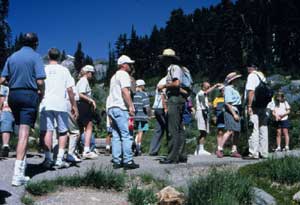|

 Research
Issues: Research
Issues:
Social Science in National Parks
(top of page)

 Social Science in National Parks:
Social Science in National Parks:

 Background:
Background:
Ensuring that national parks will survive intact for future generations remains an immense challenge. Park visitation is predicted to continue to increase over the next decade. National Park Service (NPS) managers face unprecedented needs to better understand the public's values, attitudes, and behaviors in relation to the parks for which they are responsible. They must continue to develop state-of-the-art visitor management techniques, and they must learn more about the communities and regions adjacent to park lands, as the people living nearby continue to become more involved in making decisions about the parks.
To protect plant and animal species, park managers need basic scientific information about their habitats, ranges, life cycles, and more. To protect the parks themselves, however, managers need to understand peoplethe U.S. citizens and international travelers who establish, visit, support, cherish, use, and (sometimes) abuse America's national parks and park resources. Understanding people means conducting research in the social sciencesincluding the fields of economics, psychology, geography, sociology, and political science. Park managers can use the information from social science research to protect park resources, better serve visitors, and save taxpayers money.
Sociology studies social groups, organizations, and communities, with human behavior as its central concern. It can explain demographic trends, visitor behavior, and public opinion regarding park policies. By studying the ways people are "social" with each otherhow they play, work, learn, relax, spend, and livesocial science research gives valuable insights into how people behave at different times and in different places. Just as businesses have learned to serve their customers better through research in marketing and advertising, so can the National Park Service apply social science research to serve its "customers" better (visitors and non-visitors alike) and to improve the management of the national parks.
Park Focus:
Mount Rainier National Park
North Cascades National Park
Olympic National Park
Research Needs:
Who visits national parks? When do they come, where do they come from, and what do they look for? Who doesn't visit, and why?
Who are our commercial clients ? Where do they come from? What are their experience goals while in the park?
What do non-commercial park visitors think of commercial groups? Do their respective interests and experiences in the park conflict?
How do visitors affect national park resources?
How does park management affect the visitors' experience?
How do national parks relate to their surrounding communities? How do they affect local, regional, and national economies?
How can threats to national park resources be minimized or reduced?
How effective are NPS educational effortssuch as museum exhibits, guided hikes, and ranger-led talksand how they can be improved?
How can the parks' natural and cultural resources be managed more effectively?
What factors are responsible for visitors' noncompliance with NPS resource regulations?
Available Resources:
Brown, P. J. and D. C. Wollmuth, D. C. 1984.Social science analysis and research at Mt. Rainier, North Cascades, and Olympic National Parks. Cooperative Park Service Unit, Oregon State University, 67 p.
Hospodarsky, D., K. Martinson, and D. Field. 1988. Human use of high lakes: A literature review. Oregon State University Cooperative Park Service Unit, 122 p.
Johnson, D. R. and T. C. Swearingen. 1988. Minor rule violators: A profile of off-trail hikers, Paradise Meadows, Mount Rainier National Park Research Paper CA-9000-3-0004-10.
Johnson, D. R., T. A. Swearingen. 1988 A Preliminary Analysis of Day Hiker Off-Trail Hiking in Response to Alternate Sign Texts at Selected Sites in the Paradise Meadows Area, Mount Rainier National Park. Cooperative Park Studies Unit, College of Forest Resources, University of Washington Seattle, WA. Technical Report NPS/CCSOUW/NRTR-98-04, NPS D-317
Stalmaster, M. V. 1986. Effects of recreational activity on overwintering bald eagles on the Skagit wild and Scenic River System, Washington. Pacific Northwest Res. Station US Forest Service, Portland, OR, 218 p.
Swearingen, T. C. and D. R. Johnson. 1988. An analysis of off-trail hiking in response to selected social control techniques at Paradise Meadow, Mt. Rainier National Park. Cooperative Park Studies Unit, College of Forest Resources, University of Washington, Seattle, WA.
Vande Kamp, M. E., D. R.Johnson, and J. E. Swanson. 1993. Mount Rainier National Park 1993 Spray Park Visitor Survey Field Station, Protected Area Research, USGS/BRD/FRESC, College of Forest Resources, University of Washington Seattle, WA.
Back to Research Issues
(top of page)
|




